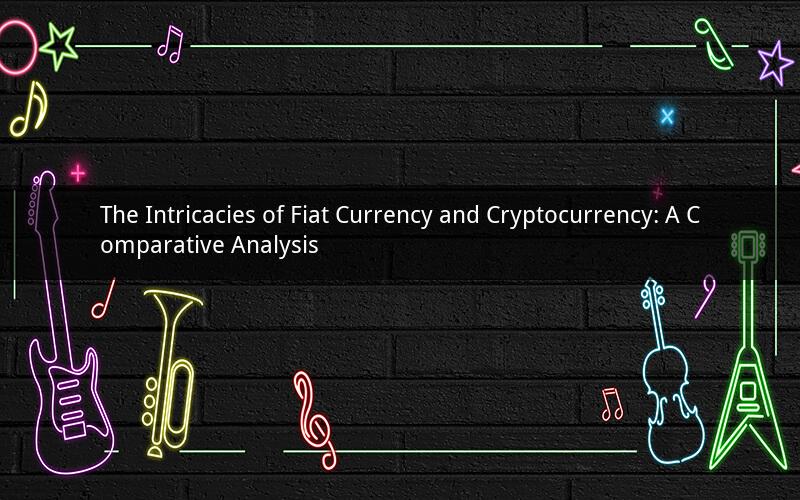
Introduction:
Fiat currency and cryptocurrency are two distinct forms of money that play crucial roles in the global economy. While fiat currency has been the backbone of traditional financial systems for centuries, cryptocurrency has emerged as a revolutionary alternative. This article delves into the definitions, characteristics, and functions of both fiat currency and cryptocurrency, offering a comprehensive comparative analysis.
1. Definition of Fiat Currency
Fiat currency is a type of money that is issued by a government and is not backed by a physical commodity, such as gold or silver. It is used as a medium of exchange, a unit of account, and a store of value. The value of fiat currency is primarily derived from the trust and confidence placed in the issuing government and its monetary policy.
2. Characteristics of Fiat Currency
a. Issued by the government: Fiat currency is authorized and regulated by the government, which has the authority to control its supply and circulation.
b. Legal tender: It is recognized as a valid form of payment for debts and obligations within the country's jurisdiction.
c. Inflationary: Governments can influence the value of fiat currency through monetary policy, such as printing more money, which can lead to inflation.
d. Physical and digital forms: Fiat currency exists in both physical (coins and banknotes) and digital (bank account balances) forms.
3. Definition of Cryptocurrency
Cryptocurrency is a digital or virtual form of currency that uses cryptography for security. It operates independently of a central authority, such as a government or bank, and is often decentralized. Cryptocurrencies are created through a process called mining, where participants in the network solve complex mathematical problems to validate transactions and add new blocks to the blockchain.
4. Characteristics of Cryptocurrency
a. Decentralized: Cryptocurrency operates on a decentralized network, such as blockchain, which eliminates the need for a central authority.
b. Limited supply: Many cryptocurrencies have a predetermined maximum supply, which makes them deflationary.
c. Digital form: Cryptocurrency exists solely in digital form and is stored in digital wallets.
d. Volatile: Cryptocurrency prices can experience significant fluctuations, often referred to as volatility.
5. Functions of Fiat Currency and Cryptocurrency
a. Medium of exchange: Both fiat currency and cryptocurrency serve as a medium of exchange, facilitating transactions between individuals and businesses.
b. Unit of account: They provide a common measure of value, enabling individuals to compare the worth of different goods and services.
c. Store of value: Both fiat currency and cryptocurrency can be used as a store of value, preserving wealth over time.
6. Differences between Fiat Currency and Cryptocurrency
a. Issuance: Fiat currency is issued by a government, while cryptocurrency is created through a decentralized process.
b. Trust: Fiat currency relies on the trust in the issuing government, while cryptocurrency operates on the principle of trust in the underlying technology and network.
c. Regulation: Fiat currency is subject to government regulation, whereas cryptocurrency operates with limited regulatory oversight.
d. Volatility: Cryptocurrency is known for its high volatility, whereas fiat currency is generally more stable.
e. Privacy: Cryptocurrency transactions can offer enhanced privacy compared to traditional banking systems.
7. The Impact of Cryptocurrency on the Economy
The rise of cryptocurrency has sparked a debate on its potential impact on the economy. Some argue that it could disrupt traditional financial systems, reduce the power of central banks, and increase financial inclusion. Others believe that cryptocurrency is a speculative asset with limited real-world use.
8. The Role of Blockchain in Cryptocurrency
Blockchain technology is the foundation of cryptocurrency. It provides a secure and transparent ledger of all transactions, ensuring that they cannot be altered or deleted. This technology has the potential to revolutionize various industries, including finance, supply chain, and healthcare.
9. The Future of Fiat Currency and Cryptocurrency
The future of both fiat currency and cryptocurrency remains uncertain. While fiat currency has been the dominant form of money for centuries, the rise of cryptocurrency has forced governments and financial institutions to reconsider their approaches to monetary policy and regulation. It is likely that both fiat currency and cryptocurrency will coexist in the future, each serving different purposes and catering to different needs.
10. Frequently Asked Questions
Q1: What is the main difference between fiat currency and cryptocurrency?
A1: The main difference lies in their issuance and control. Fiat currency is issued by a government and regulated by monetary authorities, while cryptocurrency operates on a decentralized network and is controlled by its users.
Q2: Why is cryptocurrency considered volatile?
A2: Cryptocurrency is considered volatile due to its limited supply, speculative nature, and lack of regulatory oversight. These factors contribute to significant price fluctuations in a short period of time.
Q3: Can cryptocurrency replace fiat currency?
A3: It is unlikely that cryptocurrency will completely replace fiat currency in the near future. Both have distinct advantages and disadvantages, and their coexistence seems more plausible.
Q4: How secure is cryptocurrency?
A4: Cryptocurrency is generally secure due to the underlying blockchain technology. However, users must take precautions, such as using secure wallets and enabling two-factor authentication, to protect their assets from theft.
Q5: What are the potential benefits of using cryptocurrency?
A5: The potential benefits of using cryptocurrency include enhanced privacy, reduced transaction fees, and the ability to make cross-border payments quickly and securely.